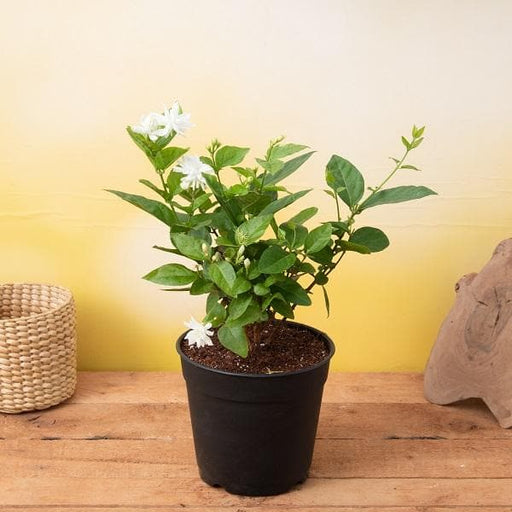
Citharexylum subserratum
(MRP Inclusive of all taxes)
- Shipping ₹79 for entire order
- Dispatch in 7 days
- Country of origin: India

(MRP Inclusive of all taxes)
 Save 29%
Save 29%
Air Purifier Money Plant with Pot The Air Purifier Money Plant, also known as Pothos or Epipremnum aureum, is a stunning indoor plant that...
View full details
 Save up to 15%
Save up to 15%
Peace Lily, Spathiphyllum - Plant The Peace Lily, scientifically known as Spathiphyllum, is a stunning houseplant celebrated for its elegant white...
View full details
 Save 25%
Save 25%
Jasminum sambac, Mogra, Arabian Jasmine - Plant Jasminum sambac, commonly known as Mogra or Arabian Jasmine, is a fragrant flowering plant...
View full details
 Save 18%
Save 18%
Combo Constituents Includes the Parijat Tree (Night-Flowering Jasmine), a culturally significant plant with fragrant flowers. Description The Pari...
View full details
 Save 25%
Save 25%
Miniature Rose, Button Rose (Any Color) - Plant The Miniature Rose, also known as the Button Rose, is a charming and compact flowering plant that ...
View full details Save 25%
Save 25%
Damascus Rose, Scented Rose (Any Color) - Plant The Damascus Rose, also known as Rosa damascena, is a timeless symbol of beauty and romanc...
View full details
 Save 17%
Save 17%
Beautiful Fragrant Mogra, Arabian Jasmine Plant with Pot The Beautiful Fragrant Mogra, also known as Arabian Jasmine (Jasminum sambac), is...
View full details Save 15%
Save 15%
Pack of Vermicompost and Neem Cake for House Plants Transform your indoor garden with our premium Pack of Vermicompost and Neem Cake, spec...
View full details
Pack of Plant Growth and Flower Boosters Unlock the full potential of your garden with our Pack of Plant Growth and Flower Boosters! This ...
View full details Save 38%
Save 38%
Combo of Jeevamrut and Neem Raksha for Easy Growth and Protection of Houseplants Transform your indoor garden with our exclusive combo of ...
View full details Save 22%
Save 22%
Plant Nutrients Kit (Pack of 16) for a Healthy Garden Transform your garden into a lush paradise with our Plant Nutrients Kit, featuring 1...
View full details Save 16%
Save 16%
Combo of Top Plant Fertilizers Elevate your gardening game with our exclusive Combo of Top Plant Fertilizers, featuring two bags of premiu...
View full details Save 24%
Save 24%
Pack of 4 Additives to Make Soil Healthy and Nutrient Rich Transform your garden into a thriving ecosystem with our Pack of 4 Additives de...
View full details Save 30%
Save 30%
Transform your gardening experience with our premium Combo of Perlite and Vermiculite. This unique blend is designed to enhance soil aeration and ...
View full details Save 27%
Save 27%
Combo of 2 Vermicompost and Cocopeat - Enrich Your Soil Naturally! Transform your garden into a thriving ecosystem with our Combo of 2 Ver...
View full details
 Save 35%
Save 35%
Best 6 Plants for Perfect Indoor Garden Transform your living space into a lush oasis with our curated collection of the Best 6 Plants for a...
View full details
 Save up to 50%
Save up to 50%
Mini Succulent Garden Pack Transform your space with our Mini Succulent Garden Pack, featuring a delightful collection of 4 any variety beautiful s...
View full details
 Save 30%
Save 30%
5 Best Fragrant Plants Transform your garden or indoor space into a fragrant paradise with our curated selection of the 5 Best Fragrant Plants. Th...
View full details
 Save 24%
Save 24%
Set of 2 Bonsai Looking Grafted Adeniums Transform your indoor or outdoor space with our exquisite Set of 2 Bonsai Looking Grafted Adenium...
View full details Save 45%
Save 45%
Top 4 Die Hard Succulents Pack Transform your indoor or outdoor space with our Top 4 Die Hard Succulents Pack, featuring a curated selecti...
View full details
 Save 30%
Save 30%
5 Best Indoor Plants Pack Transform your living space into a lush oasis with our '5 Best Indoor Plants Pack.' This carefully curated collection fe...
View full details
 Save 25%
Save 25%
Set of 4 Evergreen Air Purifier Plant Pack Transform your indoor space into a lush, green oasis with our Set of 4 Evergreen Air Purifier Pla...
View full details| SrNo | Item Name |
|---|---|
| 1 | Citharexylum subserratum |
Citharexylum subserratum, commonly known as the Jamaican Citharexylum or the 'Citharexylum', is a tropical tree native to the Caribbean and parts of Central America. This deciduous tree can reach heights of up to 15 meters and is characterized by its attractive foliage and clusters of small, fragrant white flowers. The tree produces small, elongated fruits that are a food source for various bird species, making it a vital part of its ecosystem.
With its unique aesthetic appeal and ecological benefits, Citharexylum subserratum is increasingly popular in landscaping and reforestation projects. Its ability to thrive in diverse soil types and conditions makes it a resilient choice for gardeners and environmentalists alike.
Citharexylum subserratum stands out for its dual role as an ornamental and ecological asset. Its beautiful flowers attract pollinators, while its fruits provide nourishment for birds, enhancing biodiversity. Additionally, this tree is known for its medicinal properties, traditionally used in herbal remedies by indigenous cultures.
This tree is not only visually appealing but also boasts a fast growth rate and adaptability to various environmental conditions. Its wood is durable and resistant to decay, making it suitable for crafting and construction. Furthermore, Citharexylum subserratum plays a significant role in carbon sequestration, contributing positively to the environment.
Ah, the Citharexylum subserratum, also known as the Jamaican Citharexylum or the "tree that sings" (not really, but wouldn’t that be cool?). This tropical beauty is a member of the Verbenaceae family and is cherished for its stunning foliage and vibrant flowers. It’s like the life of the party in the plant world, attracting butterflies and hummingbirds with its nectar-rich blooms.
Caring for the Citharexylum subserratum is like nurturing a diva; it requires just the right amount of sunlight, water, and love. This tree thrives in well-drained soil and prefers a sunny spot to show off its dazzling display. Just remember, overwatering is a no-no—this tree doesn’t want to feel like it’s living in a swamp!
The benefits of the Citharexylum subserratum are as plentiful as its leaves! Not only does it provide shade and beauty, but it also supports local wildlife. Birds and pollinators flock to this tree, making it a hotspot for biodiversity. Plus, its wood is durable and can be used for various purposes, making it a multitasking marvel.
The natural habitat of the Citharexylum subserratum is like a tropical vacation—lush, warm, and inviting. Found primarily in the Caribbean and parts of Central America, this tree loves to bask in the sun and soak up the humidity. It’s the kind of tree that would definitely prefer a beachside view over a city skyline.
Propagating the Citharexylum subserratum is like playing plant matchmaker. You can start this beauty from seeds or cuttings, but patience is key. Just like a good romance, it takes time to grow. Ensure you provide the right conditions, and soon enough, you’ll have a mini forest of these stunning trees.
The uses of Citharexylum subserratum are as diverse as its admirers. Beyond its ornamental appeal, the tree’s wood is prized for its strength and is often used in furniture making. Additionally, its leaves have been used in traditional medicine, proving that this tree is not just a pretty face.
The growth rate of the Citharexylum subserratum is like a teenager on a growth spurt—fast and impressive! Under optimal conditions, this tree can reach heights of up to 30 feet in just a few years. It’s a great choice for those who want a quick shade provider in their garden.
Like any celebrity, the Citharexylum subserratum has its fair share of admirers and detractors. Pests such as aphids and scale insects can be a nuisance, but with a little vigilance and the right treatments, you can keep these unwanted guests at bay. After all, no one wants a tree with a pest problem!
The soil requirements for the Citharexylum subserratum are pretty straightforward—think of it as a tree with a refined palate. It prefers well-draining soil rich in organic matter. Too much clay or compacted soil, and this tree will throw a tantrum.
Pruning the Citharexylum subserratum is like giving it a stylish haircut. Regular trimming helps maintain its shape and encourages healthy growth. Just be sure to wield your shears with care; you want to enhance its beauty, not turn it into a topiary disaster!
Incorporating the Citharexylum subserratum into landscape design is like adding a splash of color to a black-and-white movie. Its vibrant flowers and lush foliage can transform any garden into a tropical paradise. Pair it with other native plants, and you’ll create a stunning ecosystem that’s both beautiful and beneficial.
Citharexylum subserratum, also known as the black calabash tree, is a tropical beauty native to Central and South America. With its striking appearance and unique fruit, it’s like nature’s own musical instrument, ready to serenade your garden with charm and character.
You can find Citharexylum subserratum in tropical and subtropical regions, particularly in Central and South America. It thrives in well-drained soils and loves a sunny spot, making it the perfect diva of the plant world, demanding just the right conditions to shine.
Citharexylum subserratum can reach heights of up to 15 meters (about 50 feet). It’s like the skyscraper of the plant kingdom, towering over its neighbors and providing a stunning focal point in any landscape. Just make sure it has enough room to stretch its leafy limbs!
Citharexylum subserratum is not just a pretty face; its wood is prized for furniture and crafts. The fruit, while not a culinary superstar, can be used in traditional medicine. It’s like the Swiss Army knife of trees—versatile and ready for action in various roles!
Growing Citharexylum subserratum can be a breeze if you provide the right conditions. It loves warmth, sunlight, and well-drained soil. Just remember, it’s not a fan of frost, so keep it cozy, and it’ll reward you with its stunning presence!
Citharexylum subserratum prefers well-drained, sandy or loamy soils. Think of it as a plant with a taste for the finer things in life—no soggy feet for this diva! Ensure good drainage, and it’ll thrive like a star on the red carpet.
Absolutely! Citharexylum subserratum is a wildlife magnet, attracting birds and insects with its fruits and flowers. It’s like hosting a party in your garden, where the guests are nature’s finest. Just sit back and enjoy the show as the wildlife comes to visit!
While Citharexylum subserratum prefers the great outdoors, you can try growing it indoors if you have a spacious, sunny spot. Just remember, it’s a tree at heart, so it might feel a bit cramped in your living room. Give it room to grow, and it might just surprise you!
Citharexylum subserratum typically flowers during the rainy season, which varies by region. Its lovely blooms are like nature’s confetti, adding a splash of color to your garden. Just be ready for a floral fiesta when the rains come!
Citharexylum subserratum prefers regular watering but can tolerate short dry spells once established. Think of it as a plant that enjoys a good drink but won’t throw a tantrum if it misses a sip now and then. Just don’t leave it high and dry for too long!
Propagation of Citharexylum subserratum can be done through seeds or cuttings. If you’re feeling adventurous, try your hand at seed germination. Just remember, patience is key—good things come to those who wait, especially when it comes to growing this beauty!